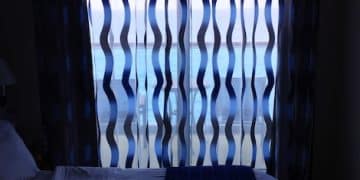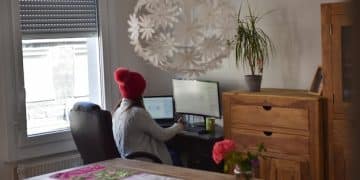Reclaim Your Life: The Benefits of a Digital Detox

A **digital detox** offers numerous benefits, including reduced stress, improved sleep, enhanced focus, and stronger relationships, by intentionally limiting exposure to digital devices and reconnecting with the physical world.
In today’s hyper-connected world, it’s easy to get caught up in the constant stream of notifications, emails, and social media updates. A **digital detox**, where you intentionally disconnect from technology, can offer a wealth of surprising benefits for your mental and physical well-being.
The Essence of a Digital Detox
A digital detox is more than just putting your phone away for a few hours. It’s about consciously reducing your reliance on digital devices to regain control over your time and attention. Let’s delve into the core concepts.
Defining a Digital Detox
Essentially, a digital detox involves setting boundaries with technology. This can range from a few hours each day to a full week or even longer, depending on your needs and goals. The goal is to reduce digital distractions and be more fully present in the real world.
Why Consider a Digital Detox?
Increased screen time is linked to various issues, including anxiety, depression, and sleep disturbances. A digital detox can help you break free from these negative patterns and rediscover the joys of offline life. It’s about creating a healthier relationship with technology.
- Reduced stress and anxiety
- Improved sleep quality
- Enhanced focus and concentration
- Stronger real-life relationships
By intentionally stepping away from the digital world, you create space for other activities that enrich your life, such as spending time with loved ones, pursuing hobbies, or simply enjoying nature.
Boosting Mental Well-being Through Disconnection
The constant stimulation of digital devices can take a toll on your mental health. Disconnecting allows your mind to rest and recharge. Here’s how a digital detox can benefit your mental well-being.
Reducing Stress and Anxiety
The endless stream of notifications and social media updates can trigger feelings of stress and anxiety. Taking a break from these digital triggers can help you feel calmer and more centered.
Improving Focus and Concentration
Our attention spans have been shrinking due to constant digital distractions. A digital detox can help you regain your ability to focus and concentrate on tasks without being constantly interrupted.
- Mindfulness and presence
- Greater emotional regulation
- Reduced feelings of overwhelm
- Improved cognitive function
Creating mental space allows you to be more mindful and present in your daily activities, rather than constantly being pulled in different directions by technology.

Enhancing Physical Health with a Digital Break
Our reliance on digital devices often comes at the expense of our physical health. A digital detox can encourage healthier habits. Let’s look at how it impacts your physical well-being.
Promoting Better Sleep
The blue light emitted by screens can interfere with your body’s natural sleep-wake cycle. Disconnecting from devices before bed can significantly improve your sleep quality, making you more rested and energized.
Encouraging Physical Activity
Time spent staring at screens often replaces time that could be spent being active. A digital detox encourages you to get up, move your body, and enjoy physical activities you might otherwise neglect.
- Reduced eye strain and headaches
- Improved posture and reduced neck pain
- Increased energy levels
- Better overall physical health
Simple things like going for a walk, practicing yoga, or engaging in outdoor activities can do wonders for both your physical and mental health.
Strengthening Relationships: Reconnecting with Loved Ones
Digital devices can sometimes create a barrier between us and the people we care about. A digital detox helps us prioritize human connection. Here’s how it boosts your relationships.
Improving Communication
When you’re not constantly checking your phone, you’re more likely to engage in meaningful conversations with the people around you. This can lead to deeper connections and a stronger sense of intimacy.
Being More Present
Putting away your devices allows you to be fully present in the moment with your loved ones. This means listening attentively, making eye contact, and truly engaging in shared experiences.
- Deeper connections with family and friends
- Enhanced empathy and understanding
- More quality time together
- Reduced feelings of loneliness and isolation
Meaningful, face-to-face interactions are crucial for maintaining strong and healthy relationships.
Practical Steps to Implement a Digital Detox
Starting a digital detox doesn’t have to be overwhelming. It’s about taking small, manageable steps to reduce your reliance on technology. Here are some practical tips to get started.
Setting Boundaries
Decide which devices and apps you want to limit, and for how long. Be realistic about what you can achieve, and gradually increase the duration of your detox periods as you become more comfortable.
Finding Alternative Activities
Identify activities that you enjoy that don’t involve screens. This could include reading, exercising, spending time in nature, or pursuing a creative hobby.

Communicating Your Needs
Let your friends and family know that you’re taking a digital detox so they understand why you might be less responsive than usual. This can help avoid misunderstandings and ensure they support your efforts.
- Turn off notifications
- Designate tech-free zones
- Schedule specific times for device use
- Practice mindful technology consumption
Remember, the goal is to create a healthier relationship with technology, not to eliminate it entirely.
Overcoming Challenges and Staying Committed
A digital detox can be challenging, especially at first. Cravings for technology are normal, but there are ways to manage them. Here’s how to stay committed and overcome common hurdles.
Addressing Initial Discomfort
Acknowledge that you might feel anxious or bored when you first disconnect. These feelings are temporary and will subside as you become more accustomed to being offline.
Building a Support System
Connect with friends or family members who are also interested in reducing their screen time. Sharing your experiences and supporting each other can make the process easier and more enjoyable.
- Use apps that block distracting websites
- Reward yourself for reaching milestones
- Be patient with yourself and celebrate small victories
- Remember the benefits and stay motivated
With a little planning and perseverance, you can successfully incorporate digital detoxes into your life and reap the many rewards they offer.
Taking periodic breaks from technology offers diverse benefits for your mental and physical health, as well as your relationships. By setting boundaries, finding alternative activities, and staying committed to the process, you can reclaim your time and attention, and reconnect with yourself and the people you care about.
| Key Point | Brief Description |
|---|---|
| 🧘 Reduce Stress | Minimizing screen time helps to reduce anxiety and stress levels by limiting digital input. |
| 😴 Improve Sleep | Reduced blue light exposure before bed improves sleep quality and regulates the sleep-wake cycle. |
| 🤝 Strengthen Relationships | Disconnecting helps to enhance face-to-face interactions and prioritize quality time with loved ones. |
| 🧠 Enhanced Focus | Digital detoxes help to improve concentration by reducing distractions from notifications and social media. |
Frequently Asked Questions
▼
A digital detox involves intentionally reducing your reliance on digital devices such as smartphones, tablets, and computers. It’s about consciously setting boundaries with technology to regain control over your time and attention.
▼
The frequency depends on your individual needs and lifestyle. Some people benefit from a short daily detox, while others prefer longer breaks on weekends or vacations. Experiment to find what works best for you.
▼
Engage in activities that don’t involve screens, such as reading, exercising, spending time in nature, pursuing hobbies, or spending quality time with loved ones. These activities can help you relax and recharge.
▼
Set realistic goals, communicate your intentions to friends and family, and find alternative activities to keep you occupied. Also, remind yourself of the benefits you’re working towards, such as reduced stress and improved sleep.
▼
It’s okay to make exceptions for essential technology use. Simply set boundaries around these uses and avoid getting drawn into non-essential digital activities. Focus on being mindful of your usage.
Conclusion
Embracing a **digital detox** is a powerful step towards reclaiming your well-being in an increasingly digital world. By deliberately disconnecting, you can unlock numerous benefits, enhancing your mental clarity, physical health, and the quality of your relationships. It’s about consciously choosing a balanced lifestyle where technology serves you, rather than the other way around.





